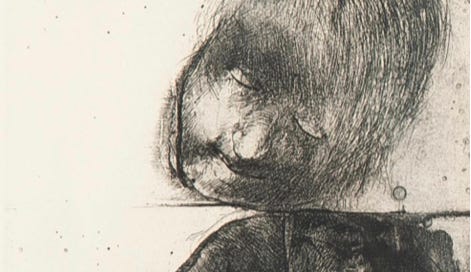Faun’s flesh is not to us, Nor the saint’s vision. We have the press for wafer; Franchise for circumcision. All men, in law, are equals. Free of Peisistratus, We choose a knave or an eunuch To rule over us. –Ezra Pound, Hugh Selwyn Mauberley [Part I]
It only recently –and by recently I mean November, when this piece finally began to coalesce– dawned on me that headlessness has tailed our marriage for some time.
Two works in our collection deal expressly with decapitation. The first is Empathy, an 1969 black-and-white etching by Robert Marx Ernst that I brought back with me to Lima from Cambridge, perhaps to hang in lieu of a diploma[t]. The other is a lithograph of The Death of Danton, by Peruvian harlequin-artist Victor Humareda, that I got Alonso on some festive pretext and that has since become his favourite divertimento of the lot.
Both are monochromatic works by artists who were not averse to color: Marx Ernst, within a refrained, melancholy palette; Humareda, with a sketchy, tragicomic truculence.
Despite this thematic affinity, the artists could also not be more tonally distinct. Marx Ernst’s Empathy is a fait accompli—the head is off; Danton’s death, on the other hand, is an accomplished fate by any measure and yet, he sits waiting for his hour to strike, with a despondent air of seccatura one might envision were he waiting in queue at the supermarket. There is also something of the classic dunce in his position. Inevitability may be less a necessary action than a sustained scrutiny.
Now, surely the armchair analyst will detect a bit of an affirming gelding subtext in this our rather strange collection, but that is only because he has not yet thought through the nuances between parricides, regicides, even deicides. They may all exist on one spectrum –in that they all abet the complete mimetic disempowerment (and yes, replacement) of the father– but that’s not accounting for heads.





